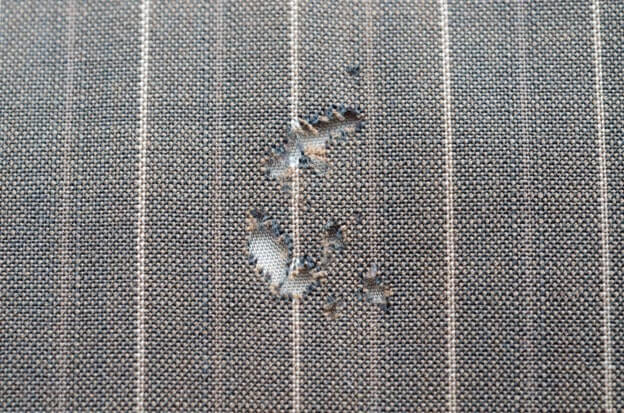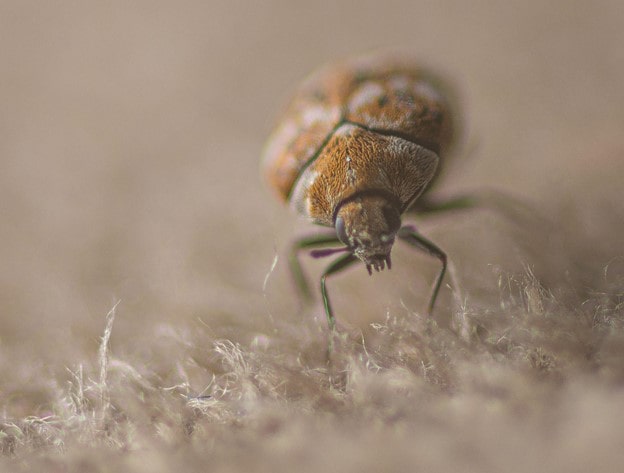Just opened your closet to find your clothing destroyed by insects? Although you might know that the culprits behind the small holes in your clothing are bugs of some sort, are you familiar with what exactly these small closet invaders are?
The most common culprits of textile damage we run across here in California are clothes moths and carpet beetles. When you get carpet beetles or moths in your closet, clothing-chomping chaos can ensue, destroying even your favorite items. Fortunately, there are some small steps you can take to help prevent closet pests from ruining your clothing, like ensuring they are fully cleaned and regularly checking for bugs. Plus, if your pest problems go too far or you just need a surefire solution ASAP, the Dewey Pest Control team is just a call away.
Common Closet-Invading Pests
While all kinds of bugs might be buzzing around your home, there are two that we see sneaking into closets and destroying clothing and other textiles most often: carpet beetles and clothes moths. While these pests are different from each other, they cause a lot of the same problems and share a feature that’s pretty rare within the bug world—the larvae of both of these pests produce an enzyme that can digest keratin, the protein in animal hair. Only a few other pests, such as silverfish, cockroaches, and termites, also have this ability but aren’t frequently the culprits behind destroyed textiles.
The Problem With Carpet Beetles and Clothes Moths
What exactly does this mean for you and you and your wardrobe? Basically, this means that textiles that aren’t completely synthetic can be a feeding source for carpet beetles or clothes moths. This doesn’t just mean fur clothing but also items made of wool, leather, silk, sometimes cotton, and blends including these textile types.
Any of these textiles that are also dirty are at especially high risk for getting destroyed by carpet beetles and moths. Even other items made up of natural fibers, like canvas-upholstered furniture, can be targets for carpet beetles and clothes moths—so unfortunately, these pests won’t necessarily only attack your clothing. This also means that commercial entities looking to eliminate pest risks need to be watchful for these pests when storing natural textile-based items.
Identifying and Eliminating Carpet Beetles and Clothes Moths
Whether you’re battling carpet beetles or clothes moths, you can be in for a big hassle. It helps, however, to know which kind of pest is creating your problems and how you can work to prevent or remove them.
Carpet Beetles
Wondering if you have carpet beetles in your closet? Keep an eye out for small beetles (which can vary in color or even be multicolored) as well as larvae that look a little bit like small caterpillars. These larvae are actually the ones that will feed on clothing, and they can stay in this stage for several years. A telltale sign of an infestation will be finding damaged clothing and textiles. Seeing molted skin pieces can also be a sign that bugs, potentially carpet beetles, are in your space.
How to Prevent or Get Rid of Carpet Beetles
If you know or suspect you have them, you’re probably wondering how to get rid of carpet beetles. Generally, ensuring your textiles and other surfaces are as clean as possible can help make these areas less appealing for carpet beetles. If you have items that are currently infested with carpet beetles, make sure to get them away from your undamaged items as soon as possible, clean your clothing items and space thoroughly, and keep a watchful eye out for continued signs of damage and pest activity. Be sure to also regularly vacuum carpets, as they can make great hiding places for these bugs. Make sure to check and clean tight spaces to ensure you catch a possible infestation on the rise as quickly as possible. To help keep bugs out of undisturbed items, make sure to clean them and store them in airtight containers made of materials that carpet beetles won’t be attracted to.
Although carpet beetles aren’t considered a particularly hazardous pest for humans, you don’t want to mess around with bugs for too long. For one, they’re unhygienic, and secondly, you don’t want them destroying your belongings. When you need advanced carpet beetle control, you can work with a pest control company to find a safe, effective solution, like installing bug traps and performing pest treatments.
Clothes Moths
Most will find clothes moths fairly easy to identify. Adult clothes moths are generally small and off-white in color. They look similar to other moth types but are typically more reclusive and tend to stay in darker spaces rather than being attracted to light. At around a quarter-inch or half-inch in size, they are also quite a bit smaller than many other common moths. The clothes moth larvae, which pose a threat to your textiles, look like small, white, or light brownish non-fuzzy caterpillars with darker heads. Certain kinds of clothes moth larvae also have noticeable cases attached to their back ends.
As with carpet beetles, one of the biggest signs you have clothes moths in your closet is seeing them or finding damage to your clothing. Our best tips for how to get rid of moths, specifically closet-invading moths, are similar to those for carpet beetles.
How To Prevent or Get Rid of Clothes Moths
Clothes moths are especially interested in natural fibers that have been soiled with food or body oils, so ensure your clothing is clean before you store it, and regularly check for bugs so you can move your clothing ASAP if you detect a possible infestation. Because clothes moths prefer dark, undisturbed areas, keeping your closet open and regularly moving items around can also help make your closet less appealing to a would-be closet moth population.
If you do find yourself needing to get rid of invading moths, dispose of any infested clothing, clean your closet and the items in it totally, and when possible, store natural fiber-based items in airtight, non-fabric containers. Additional options, including freezing items, using mothballs, and having anti-moth treatments carried out by a dry cleaner, can help protect specific items. If you opt for this route, be sure to fully understand the risks of damage these treatments could pose to your belongings, the health hazards of using pesticide products (especially mothballs), and make sure to check how long you can expect these products to help protect your clothing. As with carpet beetles, professional pest control is often the safest, most effective, option for serious clothes moth infestations.
Beware of Closet Pest Prevention Myths
Now that you have some insight on the right ways to get rid of carpet beetles and moths, there are a few closet pest prevention myths you should be aware of, so you don’t waste your time and money on solutions that don’t work. For one, it’s probably not worth investing in cedar storage containers to try and protect your clothing. Even a well-sealed and constructed one is only able to provide protection against clothing-destroying pests for a limited amount of time. Similarly, cedar liners probably won’t work long term.
Be careful also with overspending on essential oils to repel pests in general. These types of remedies often don’t fully work and can become quite expensive. Additionally, trying to remove closet pests with herbs will likely not work, and might even just create an attraction for other pests. Despite being fairly common items, you should also be extra cautious if you choose to use moth balls or moth crystals, as they can be quite dangerous to people and household pests.
Take the Next Step and End Your Closet Moth or Beetle Problem for Good

While good housekeeping and keeping your clothing clean can do a great job of preventing closet moths and beetles, they can be very difficult to get rid of once you have them. The team at Dewey Pest Control can help you end the battle against closet pests once and for all. Just contact us! We’re proud to offer green, environmentally friendly pest control for closet pests and all sorts of other troublesome critters to households and businesses throughout California.



